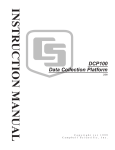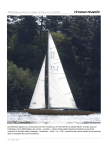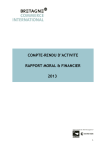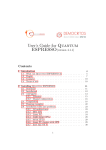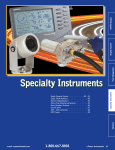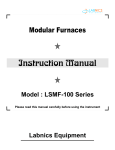Download Campbell SAT SCD Specifications
Transcript
A newsletter for the customers of Campbell Scientific, Inc. March, 2001 www.campbellsci.com Volume 12, Issue 1 NESDIS certifies High Data Rate transmitter SAT HDR GOES becomes the only one of its kind On November 3, 2000, our SAT HDR GOES transmitter became the only GOES satellite transmitter certified by NESDIS to comply with the High Data Rate (HDR) specifications. The transmitter supports both low and high data transmission rates including 100, 300, and 1200 bps. The SAT HDR GOES is manufactured for Campbell Scientific by Seimac Ltd., Dartmouth, Nova Scotia, Canada. Satellite transmitters are well suited for remote data collection. The SAT HDR GOES transmitter uses the GOES satellite system to provide one-way communications from a Data Collection Platform (DCP) to a receiving station. GOES satellites maintain equatorial orbits that coincide with the Earth's rotation allowing each satellite to remain fixed above a specific location. Federal, state, or local government agencies in the US, or users sponsored by one of those agencies, may use GOES. Setting up the SAT HDR GOES transmitter is easily accomplished using your computer and the Windows-based software included with the transmitter. The transmitter stores data in independent 16 Kbyte buffers for self-timed or random transmission; transmission lengths from one to 120 seconds are supported. Short transmission lengths also enable multiple stations to use the same NESDIS-assigned window. The SAT HDR GOES from Campbell Scientific supports data transmission rates of 100, 300, and 1200 bps. A GPS receiver and antenna are included to acquire time and position data. Clock accuracy is especially important for satellite telemetry, and the GPS receiver allows automatic GPS correction of clock and oscillator drift, increasing the accuracy of the transmitter's clock. Diagnostic, transmission status, and self-test information can be sampled by the datalogger and transmitted over the GOES system as part of the data stream. Information that can be sampled includes: • Power supply voltage under transmit load • Location (latitude and longitude) • Bytes in buffers • Time until next self-timed or random transmission • Forward and reflected power • Transmit time (GMT) • Message length • Watch dog dropouts • Power supply dropouts Typically, a DCP includes the transmitter, Campbell Scientific datalogger, Yagi antenna, enclosure, and a power supply that often consists of Campbell Scientific's BP12 or BP24 battery, CH12R Charger/Regulator, and MSX10 solar panel. The SAT HDR GOES is compatible with our CR510, CR10X, and CR23X dataloggers. !! Price lists for 2001 now available; additional information also accessible Our US, International, and systems price lists for the year 2001 are available; pricing became effective 1 January 2001. You can receive any of our price lists via email, fax, or mail by contacting one of our applications engineers. While most prices did not change, some products have either slightly increased or decreased in price due to changes in our parts or manufacturing costs. If you need additional information, look for this symbol ! at the end of an article. Then, to receive literature through the mail, please make your selections on the enclosed customer response form. The ! symbol indicates specific information that can be found on the Web at www.campbellsci.com and its subpages. Page 2 Message from the President Customer-focused service is our commitment ING ET NERAL MA GE MA RK OS/software upgrades now available on the Web Several of our software offerings can now be upgraded electronically via our Web site. Visit our Upgrades page at www.campbellsci.com/upgrades.html to obtain PC208W/P, SM4M/16M Operating System (OS) upgrades, and CR10X OS upgrades. The procedure is simple. On the upgrades page, type in a few identifiers, including a username and password. Select the upgrade you want and click "Submit." You’ll get a confirming email that contains instructions for downloading the file(s) selected. For future upgrades, only your username, password, and upgrade selection will be required. ! G RIN MINISTRATION AD installed on your computer. The patch will self-extract, look for a qualifying version of PC208W on your PC, and update the necessary files. If you want the patch on CD, you can order PC208W/P for $25 (minimum order of $50 still applies). If you want to upgrade from an earlier version of PC208 (DOS) or PC208W (Windows), you need to purchase the PC208W/U upgrade. ! CUSTOMER advances in communications. If you haven’t visited our Web site recently, I encourage you to browse and see where you can find application notes to augment our technical support for your work. There are manuals on the Web site for most of our peripheral products. Tutorials are available if you are just getting started or need to refresh your familiarity with our dataloggers. E-mail may be generally directed to our webmaster, but it is helpful to identify the application so the reply may be made by the application specialist in that area. Our application engineers have opportunities for face-to-face communication with customers at trade shows, providing training courses, or when providing site consultation services. I hope that your experience getting information from us is positive and efficient by whatever means you choose. PC208W patch available at no charge Customers may now download a free patch from our Web site to update their PC208W 3.x Datalogger Support Software to the current shipping version. The patch allows you to take advantage of new features and bug fixes if you have any version of PC208W 3.0 or later. To obtain the patch electronically, visit www.campbellsci.com/upgrades.html and follow the instructions. For the patch to work, you must already have PC208W NG MA RANCE SU AS QUA ENT LIT EM G Y C A A T F U U R N I N ENGIN Campbell Scientific’s organizational chart comes from a similar one I saw a number of years ago in an article written by an airline executive. The common element of both charts is the placement of the customer in the center. Campbell Scientific is an instrument manufacturer, and as such, the primary functions that add value for customers are marketing (communicate with and give support to the customer), engineering (specify exactly what we make and how we make it), and manufacturing (make it and ship it to the customer). These primary functions are supported by an infrastructure of general management (allocate and coordinate resources), administration (pay the bills), and quality control (set standards and provide quality guidelines and feedback within the organization). Since our primary means of interfacing the organization to you, the customer, is through our Marketing and Customer Service Department, let me give some more details of how that department is organized. Groups within the department are: Environmental, Water Resources, and Industrial. In addition, there are groups for Order Entry, Customer Service and Repairs, and Software Support. Providing good technical support for our products is a high priority for our application engineers (AEs), as well as familiarity with customers’ applications for the products. This first line of application engineering support for customers is backed with more specialized groups. There is particular demand for technical support of PC software that runs with Campbell Scientific dataloggers like the CR10X. The software support group provides a nucleus of expertise to the AEs, and the group also takes the lead on new software design, on-line help, and testing. We have organized our phone and e-mail systems to make your contact with an application engineer in the applicable market as efficient as possible. The business you do with the company will usually be conducted through one or two individuals with whom you establish contact and dialog. It helps us to serve you better if you can identify with one of our primary marketing groups and consistently direct your communication, whether it be by phone, e-mail, or fax, to the same person until the transaction is completed or the issue at hand is resolved. The Internet has provided significant EE By Paul Campbell A newsletter for the customers of Campbell Scientific, Inc. Executive Editor: Bert Tanner Managing Editor: Jeff Goalen Assistant Editors and Update Design: Tracy Weber Davidson Linda Worlton Jared Thayne Contributing Writers: Janet Albers Rachel Christensen Bryan Dixon John Halloran Neal Israelsen Larry Jacobsen Austin McHugh Doug Neff Lex Shakespear Graphics/Photography: Hoa Pham Lex Shakespear Jared Thayne www.campbellsci.com Copyright © 2001 Printed March, 2001 Page 3 The AM16/32: A smaller, more robust multiplexer The AM16/32 Multiplexer combines the functions of our AM416 and AM32 Multiplexers. A toggle switch allows you to configure the multiplexer to switch 16 sets of 4 lines at a time (4 x 16 mode) or 32 sets of 2 lines at a time (2 x 32 mode). In either case, a maximum of 64 lines can be input to the multiplexer. Signals from the datalogger’s control ports trigger advancement from set to set, sequentially routing signals from each connected sensor through the multiplexer’s common (COM) terminals. The AM16/32 is smaller and more robust than its predecessors. In 2 x 32 applications, it uses one less differential input channel than would be required if an AM416 were used for the same purpose. Multiple strain relief eyelets are built into the multiplexer; a cover is also provided to shield the multiplexer terminal strips and connected wires from inadvertent jostling and dust. As with its predecessors, the AM16/32 requires an environment free of moisture and condensing Multiplexer Support in SCWin Version 1.1 The popular SCWin Program Generator software now has even more functionality—it supports Campbell Scientific multiplexers. SCWin is a software application that generates a datalogger program for you—no more trying to remember the right set of program instructions for each sensor or output option. You choose the datalogger type, sensors, and output(s) you want and SCWin does the rest. With Version 1.1 you can choose the AM416, AM32, AM25T, or the AM16/32 multiplexer. SCWin will show you a list of sensor configurations available for that multiplexer. For convenience, you can add multiple sensors at the same time. A wiring diagram is produced and you can even print out the wiring instructions. A beta version of SCWin 1.1 is available at the following address: www.campbellsci.com/resource.html If you find problems, want to be notified of new releases of SCWin, or have ideas for improvements, please let us know by email: [email protected] ! The AM16/32 can be configured for 32 sets of 2-wire sensors (channel numbers in white), or 16 sets of 4-wire sensors (channel numbers in blue). Select the desired configuration before use by positioning the switch (white switch surrounded by red square). humidity; our AM ENC environmental enclosure is recommended. Multiplexers do more than increase system channel capacity; they can also significantly reduce the cost of sensor cabling, especially in applications where long leads are required. In cases where sensors are clustered at some distance from the datalogger, the multiplexer is typically located in the middle of the sensor spread. The MUXSIGNAL-L and MUXPOWER-L cables are used for the long cable run, while expensive sensor leads are kept short. !! Speed rivals PC-based systems CR9052DC updated with FFT spectral analyses We have added real-time Fast Fourier Transform spectral analyses to the CR9000 Measurement and Control System by updating the code in the CR9052DC Anti-Alias Filter Module. The high-performance DSP in the CR9052 rivals the speed and capabilities of PC-based systems. In addition, the CR9000 system offers a rugged, portable, 12 Vdc powered solution. The CR9052 can perform 2048-point FFTs on six channels in real-time. The normal processing sequence is to collect a snapshot of time-series data, apply a time-series window (optional), perform the FFT, normalize the results into spectra (amplitude and phase, power, power spectral density, and dB are options). In addition, the CR9052 can combine adjacent spectral components to provide 1/n octave analyses. !! The CR9052DC’s (right) anti-alias and FFT capabilities add functionality to the CR9000 Measurement & Control System. CR9052DC featured in international publication The November edition of Testing Technology International, a U.K.-based periodical specializing in measurements germane to vehicle testing, featured an article about our CR9052DC anti-alias filter card for the CR9000 Measurement and Control System. The article explains the exceptional capabilities provided by the CR9052 for antialias rejection on analog voltage measurements and the CR9052’s ability to perform near real-time Fast Fourier Transform analyses. A PDF version of the article appears on our Web site. ! Page 4 DCP100 reconfigured to include SAT HDR GOES G 12V Logan, Utah SW 12V CTRL SE DIFF 7 8 9 L AG H 2 3 4 G G H 10 5 11 12 6 L AG E3 L AG H 4 5 SW 12V AG G G 5V 5V G G 12V POWER IN CS I/O G CR10X WIRING PANEL MADE IN USA SE DIFF 1 2 1 G G H L AG H 6 SDM 3 L AG H L AG E1 P1 G AG E2 G P2 G C8 C7 C6 C5 C4 C3 C2 C1 G 12V 12V EARTH GROUND WIRING PANEL NO. thia ia thia ia thia thia thia thia thia thia thia thia thia thia thia thia thia thia tryu to read this whoever thia thia thia thia thia thia thia thia thia thia thia thia thia thia thia thia thia thia BATT INT ON OFF EXT CHG CHG +12 +12 ASLFJO AKDASLFJO AKD ASLFJO AKD ASLFJO AKD ASLFJO AKDASLFJO AKD ASLFJO AKD ASLFJO AKD ASLFJO AKDASLFJO AKD ASLFJO AKD ASLFJO AKD ASLFJO AKD ASLFJO AKD ASLFJO AKD DESI PAK. DESI PAK. SPECIFICATION MIL-D-3463 SPECIFICATION MIL-D-3463 ALDLIFJ KALDHFI;O AKJI AI AJHFHO ALDLIFJ KALDHFI;O AKJI AI AJHFHO ASLFJO AKD ASLFJO AKD ASLFJO AKD ASLFJO AKD ASLFJO AKD ASLFJO AKD ASLFJO AKD ASLFJO AKD ASLFJO AKD ASLFJO AKD ASLFJO AKD ASLFJO AKD ASLFJO AKD ASLFJO AKD ASLFJO AKD ASLFJO AKD ASLFJO AKD ASLFJO AKD DO NOT EATDO NOT EAT DO NOT EATDO NOT EAT DESI PAK. DESI PAK. ASLFJO AKD UNITED DESICCANTS-GA UNITED DESICCANTS-GA TES TES UNITED DESICCANTS-GA UNITED DESICCANTS-GA TES TES SPECIFICATION MIL-D-3463 SPECIFICATION MIL-D-3463 KALDHFI;O AKJI AI AJHFHO KALDHFI;O AKJI AI AJHFHO ALDLIFJ ALDLIFJ DES DES I PA I PA K. K. ASLFJO AKD UNITE UNITE D DESIC D DESIC CANTS CANTS -GATE UNIT UNIT -GATES S ED DESI ED DESI CCAN CCAN TS-G TS-G ATES ATES Campbell Scientific systems have been configurable as Data Collection Platforms (DCPs) for many years. The DCP100 combines the necessary components into a single compact package to make configuring your DCP system as easy as 1-2-3. 1) Specify a Campbell Scientific DCP100; 2) choose a datalogger option; and 3) choose a power supply option. There is no need to specify a transmitter, antenna, enclosure, or battery charger; all are included in the DCP100. If you already have a Campbell CR510, CR10X or CR23X, we can build a DCP100 around your datalogger. For more information, please contact one of our applications engineers. !! ASLFJO AKD The DCP100 has been reconfigured to include Campbell Scientific’s state-of-the-art High Data Rate Transmitter, the SAT HDR GOES (cover story). The DCP100 combines the measurement and control capabilities of our dataloggers with the broad geographic coverage afforded by GOES (Geostationary Operational Environmental Satellite) telemetry. With an operating temperature range of -40° to +60°C, the DCP100 is a rugged, reliable system even in extreme, remote environments. Federal, state, or local government agencies in the US, or users sponsored by one of those agencies, may use GOES. Potential GOES users must receive formal permission from NESDIS. Typically, a satellite telemetry system includes an environmental enclosure that houses a datalogger, power supply, cabling, and transmitter. A storage module is also shown. SC532A peripheral interface proves multifunctional The SV8PLUS receives satellite signals, calculates its location on Earth, and outputs a data stream to a Campbell Scientific datalogger. GPS receiver now available for use with CSI dataloggers The Trimble Navigation model SV8PLUS GPS receiver is available as a standard product on our 2001 price lists. The SV8 receives signals from orbiting satellites in the Geographic Positioning System, then calculates its location on the Earth’s surface, and outputs a data stream to the datalogger via an RS-232 port. The SV8 can receive up to eight channels of GPS data; number of channels received at any particular point in time depends on the number of satellites "viewable" above the horizon. The receiver can also support differential correction. The SV8 is factory set to output data at 1200 bps, allowing the CR10X to input the GPS data directly via its con- trol ports and Program Instruction 15 (P15). GPS time, position, and velocity information can be monitored. P15 can also be used to turn the GPS on and off, thus reducing the power budget when GPS data are not needed. The datalogger time can be set to match the GPS time or local time with the accuracy of the GPS signal. The SV8 also provides a timing pulse at one second intervals. The timing pulses are extremely accurate and can be used to synchronize time between several instrumentation sites even when they are separated by a great distance. The standard SV8 includes an active patch magnetic mount antenna, mounting bracket, power cable and RS-232-tocontrol port communication cable. !! The SC532A interfaces Campbell Scientific peripherals to the serial port of a PC. The SC532A has three basic functions and an internal jumper; the jumper setting determines how the SC532A works. The SC532A can interface the PC to: 1) Our SM4M, SM16M, SM716, and SM192 Storage Modules. In this case, data and datalogger programs can be transferred in either direction (use factory jumper setting). 2) A COM200 telephone modem to use as a calling modem. 3) A SAT ARGOS or SAT SCD/ ARGOS or transmitter. Typically used to preprogram the transmitter while in the office (set jumper to program position). The SC532A is a direct replacement for the SC532. Major changes include the additional functionality referenced above, a smaller size, and a 9-pin serial port as opposed to a 25-pin serial port. Also, the power cable/ac adapter is no longer an integrated part of the product, allowing the SC532A to be powered by a removable ac adapter or connected to battery power via an optional field cable (part number 14020) that plugs into a datalogger CS I/O port. ! Page 5 SDMs added to product line Campbell Scientific’s SDMs (Synchronous Devices for Measurement) are microprocessor-controlled measurement and control peripherals that augment the measurement and control capabilities of most Campbell dataloggers. Once enabled, the SDMs operate independently of the datalogger until additional commands are received or results are transmitted. Each SDM is configured with a unique address and is controlled/interrogated via a single datalogger programming instruction. Up to 16 SDMs can be operated by one datalogger; the SDMs are wired to the 12 Vdc, GND, and three SDMcompatible control ports on a CR10X, CR23X, CR7, or CR5000. The SDMs listed below are new to our product line this year; all were designed by our European affiliate, Campbell Scientific Ltd. SDM-CVO4 outputs voltage or current signal The SDM-CVO4 is a four-channel device capable of outputting either a voltage signal (0 to 10 V) or a current signal (0 to 20 mA). The signal level is under datalogger program control, typically by Program Instruction 103 (also used for the SDM-AO4). Typical applications are driving remote "current loop" display units, retransmitting measured New to the CSI values to industrial control systems product line this year, the that have current or voltage inputs, SDM-CVO4 can output voltage sending control signals to valve signals up to 10 Vdc and current controllers, and providing excitation signals up to 20 mA. voltages or currents to external sensors which cannot be excited directly by a datalogger. !! New SDM-CD16D expands digital output The SDM-CD16D is a 16-channel device that expands the digital output capabilities of Campbell Scientific dataloggers. Output voltages are 5 V (nominal, high state) and 0 V (nominal, low state). Output source current is 36 mA at 3 Vdc. The SDM-CD16D is intended for use with dc-powered devices only, to drive normal logic level inputs as well as directly control low voltage valves and relays. A related Campbell SDM product, the SDM-CD16AC, is rated for ac use. !! SDM-CAN: The CANbus network interface The SDM-CAN interfaces a Campbell Scientific datalogger directly to a CANbus peripheral or communications network. CANbus is a communication protocol developed for robust data transfer; it is becoming widely used in the automotive test industry as part of on-board vehicle diagnostic systems. Data acquired by a vehicle’s onboard "computer" is exported to the datalogger where it can be stored and synchronized with a variety of other measurements. This allows storage of comprehensive time-series data, onboard system operation to be verified by independent measurements, and the capability to measure a large number of additional or unique sensors "in parallel" with the diagnostic system (e.g., GPS data, additional pressure, flow, temperature measurements). The SDM-CAN is configured for individual tests within the datalogger program; a 9-pin RS-232 is also available to update firmware to the SDMCAN from a PC. Baud rates up to 1 Mbaud are supported by the SDM-CAN. ! To better meet customer needs, Campbell Scientific Capital, Inc., offers short-term rentals and long-term leases of the CR5000 (left), CR9000 (center), and CR23X (right). Equipment leasing, rentals now available through CSCI By Robert Carpenter Campbell Scientific Capital, Inc. To serve the changing needs of our customers, Campbell Scientific has created a rental/leasing organization, Campbell Scientific Capital, Inc. (CSCI). CSCI offers short-term rentals, long-term leases, and leaseto-own purchase options of Campbell Scientific equipment. Campbell Scientific Capital was created because we realized that renting or leasing additional dataloggers to get a job done makes sense for some customers. We currently offer the CR23X Micrologger, and the CR7, CR5000, and CR9000(C) Measurement and Control Systems. To help meet additional application needs, we also offer a variety of datalogger peripherals: multiplexers, some SDM devices, many communication peripherals, and external data storage devices for data retrieval. As with our corporate parent, we accept MasterCard, Visa, and American Express credit cards. Visit our Web site at the following address: http://leasing.campbellsci.com or give us a call at (435) 750-9560. !! Page 6 TB4 Tipping Bucket Rain Gage added to CSI’s 2001 price lists The TB4 Tipping Bucket Rain Gage has been added to our US and International Price Lists and is offered alongside the CS700. Both gages are manufactured by Hydrological Services Pty. Ltd. Like the CS700, the TB4 measures its catch in 0.01" increments and has a siphoning mechanism that causes captured rain to flow to the tipping buckets at steady rates, enabling accurate measurements during intense rainfall events (up to 700 mm hr-1). The major difference between the gages is the base. The TB4 has a white, UV stabilized plastic base whereas the CS700 has a powder-coated aluminum base. As a result, the TB4 is less expensive and weighs less. !! Removable HMP41 a convenient option for the HMP45C For optimum results, your HMP45C Temperature/Relative Humidity sensor should be recalibrated annually. If you’ve found it inconvenient to rewire a replacement sensor to your datalogger while the original is being recalibrated, the HMP41 is for you. The HMP41 is a removable sensor head that is compatible with any HMP45C sensor. Simply "unplug" the sensing element of the HMP45C and replace it with an HMP41. Given this, one or two spare sensor heads can facilitate scheduled recalibrations over an entire network. !! With no rewiring necessary, the HMP41 (shown with yellow protective cap) can replace sensor heads sent in for recalibration. CS410 Shaft Encoder redesigned The CS410 Shaft Encoder for water level measurement has been redesigned. The old design used a "silverin-glass" technology which resulted in a high starting torque. The new design uses an optical sensor that reduces the starting torque to < 0.125 in-oz, considerably less than the previous design. The resolution of the CS410 is ±0.01 feet using a standard one-footcircumference pulley. The low price, high resolution, and environmentally rugged construction of the CS410 make it ideal for many surface water applications. !! The redesigned CS410 Shaft Encoder uses an optical sensor that reduces starting torque to a point considerably less than that of the previous design. Regional sales engineers offer support Campbell Scientific, Inc., has formed a sales group to provide support for regions of the US not served by our existing sales network. The sales group is currently staffed by two regional sales engineers, who are full-time salaried employees without the distraction of commissionbased pay. Because they were trained as applications engineers, they are well-versed in Campbell Scientific’s product line. They conduct monthly sales trips to existing and potential customers, as well as generate and follow up quotations and literature requests. The primary goal of a sales visit is to understand specific customer needs and product use. They can then recommend data acquisition solutions and provide on-site technical support, product demonstrations, and customized instruction. Many customers have benefited from improved product knowledge stemming from these visits. Sales engineers are assigned to the Northwest (purple; includes AK and HI) and Northeast (hachures) areas. Sales reps are also shown. If you are in the northwest or northeast parts of the US, you can request a visit from one of these sales engineers, or continue to work with your current application engineer at the factory. The map above offers a quick idea of sales territories; details of markets served and contact information can be found at www.campbellsci.com/usreps.html ! It’s your choice: Hardcopy or e-mail? Electronic Campbell Update now just a click away As of this printing, you can choose to receive electronic notification via e-mail each time a new version of The Campbell Update is available. The e-mail will contain a link to the location on our Web site where you can download the newsletter or view it online. You can also opt out of receiving the Update as a hard copy through the mail. Nothing will change for those who choose to continue receiving a hard copy. If you wish to receive the newsletter electronically, please take a moment to visit us on the Web at: www.campbellsci.com/list.html to access the electronic sign-up form. ! Page 7 Large power requirements? New solar panels can help For applications with large power requirements, we’ve added the MSX64R and MSX128R Solar Panels to our product line. They are regulated solar panels with peak output power of 64 and 128 Watts, respectively. Both panels are designed to support solar recharge of deep cycle marine batteries. Attaching the power leads to the posts of a deep cycle battery is made more convenient using our terminal strip adapter, part number 4386. If you own an MSX64R and decide you need more power, you can order an unregulated 64 Watt panel (part number 13968) that connects to an MSX64R to increase the peak output power to 128 Watts. Typically, the only products available from Campbell Scientific that require this much power are the 023/CO2 Bowen ratio and CO2 Eddy Covariance systems. Campbell Scientific strives for instru- mentation designs that have minimal power requirements. It is perhaps telling that these "large" solar panels have power output ratings equivalent to the power requirements of one household light bulb! Most of our systems can be easily powered with a 10 Watt solar panel. We recommend that you use our Application Note 5-F to calculate the specific power requirements of your data acquisition system. !! BP12, BP24: When your power supplies need to be hearty BATT INT ON OFF EXT CHG CHG +12 +12 G 12V Logan, Utah SW 12V CTRL SE DIFF 7 8 9 10 5 4 G G H L AG H 11 12 6 L AG E3 AG G G L AG H SW 12V 5V 5V G G 12V POWER IN CS I/O G CR10X WIRING PANEL MADE IN USA SE DIFF 1 2 3 4 5 2 1 G G H L AG H 6 SDM 3 L AG H L AG E1 AG E2 G P1 G P2 G C8 C7 C6 C5 C4 C3 C2 C1 G 12V 12V EARTH GROUND WIRING PANEL NO. Shown in an environmental enclosure, a BP12 (top) is typically wired to a charging regulator, such as our CH12R. RF313 UHF radio is now available The RF313 UHF radio is now available; it supports transmissions over frequencies in the 400 to 430 MHz band. Power requirements vary from application to application depending on the instruments in the system, datalogger scan rate, ambient temperature, and availability of a power source to recharge system batteries. Satellite transmitters, for example, have large power needs. Other stations might be expected to operate unattended with minimal recharge over long periods. These systems may require a rechargeable power supply with more capacity than those typically sold with our dataloggers (e.g., PS12LA, CR23X and CR5000 rechargeable battery bases). Campbell Scientific offers the BP12 and BP24 battery packs for these systems, which have nominal ratings of 12 and 24 Ahrs, respectively. These batteries should be connected to a charging regulator, typically our CH12R, and a charging source, such as ac power or a solar panel. The charging source powers the datalogger system while float-charging the batteries. The batteries provide back-up power to the datalogger if the charging source is interrupted. The charging regulator also controls the current flowing to the battery and prevents the battery current from flowing to the charging source. For information about analyzing your system's power requirements, see our Power Supply brochure or CSI Application Note 5-F. !! Push-To-Talk serves as RF diagnostic tool DRL or Maxon Radios purchased from Campbell Scientific include a cable to connect the radio to its modem. This rainbow-colored cable includes a 10-pin rectangular connector to which a PTT (Push-To-Talk) Button can be attached. This button (part number 13855) is used to trigger a brief transmission by the radio which can assist in verifying operation of each RF transceiver in a system. It is intended as a short-term diagnostic tool to optimize RF performance and should not remain connected. Connect two modems to a datalogger with SDS-122 As with other Maxon radios, the RF313 is compatible with the RF310B base station and the RF310M radio modem. It is not compatible with other RF systems, including the RF300RF304 radios, RF95(A) modems, or RF232(A) base stations. An FCCassigned frequency is required to order. !! The SDS-122 is a two-way data switch that allows two modem devices to be connected to one datalogger. For example, this allows you to toggle between retrieving data from the datalogger locally (e.g., with a laptop computer) while the datalogger is also connected to a telephone modem. The SDS-122 is controlled by a datalogger control port or logic signals. The SDS-122 can support both DTE and DCE devices without the need for a null modem cable, and can operate in either automatic or manual mode. ! Double-notch bracket option added for the ENC 16/18 The 13826 double-notch bracket has been added as an option for the ENC 16/18 enclosure, and is recommended for attachment to our UT10 10-foot tower. The triple notch bracket option should still be ordered when attaching the enclosure to our CM6/10 tripods, UT20 tower, or UT30 tower. !! Page 8 CR5000/CR9000 software: the evolution of PC9000 Customer suggestions lead to overall improved product Originally planned as temporary software for the "soon-to-be-released" CR9000 Measurement and Control System, our PC9000 Software has evolved over the past seven years. In its infancy, it could transfer a program to the CR9000, set the CR9000 clock, display real-time data, and collect data files. The initial program generator was soon developed; it could create programs to make fundamental measurements and support various data storage rates. Today, all PC9000 features are captive within a Multi-Document Interface (MDI). This technology makes it easier to have several windows, of the same or different type, open at the same time. The windows can be tiled or cascaded as desired. Requests for additions and changes to PC9000 started with our first CR9000 customers. Consequently, the Program Generator now includes Battery Saver, Status Monitor, Conditional Power Off based on time and/or measurements, Triggered Burst, Rain Flow Histogram, Level Crossing Histogram, Triggered Event Tables, Write If..., Table Times calculator and Calculated Fields. Calculators for y=mx+b, RPM, Speed, Liquid Flow, mV per Volt sensors, and Potentiometers and Resistance were also added. Support for new hardware includes Conditional setups to read and write to ports, the ability to set flags and Continuous Analog Outputs, and an interface to the CR9052DC Filter Module and SDMCAN module. A new Alarms List real-time window allows the user to set two alarm levels for each of several different measurements. All alarm condition measurements, or combinations of measurements, are viewable in the window. Alarm conditions are also logged to a file to show the time the alarm started and ended for each alarm level. A new DDE Linker real-time window can simultaneously display 50 channels of data. Since 10 of these windows can be open at once, up to 500 channels can be available for DDE linking. A PC running PC9000 while connected to a CR9000 can provide the logger’s data to everyone on a network. In fact, if more than one PC9000/CR9000 system is running with DDE Linkers open, then anyone on the network can access data from all loggers at the same time. The easiest way to access the data is to set up an Excel or similar spreadsheet for DDE, then select the logger and data points desired. This works well for graphically viewing data in pseudo real-time. One copy of Excel can display several graphs from the same or different loggers. Our tests have shown that it is possible to transfer up to 200 data points per second using this method. This method is not recommended to remotely collect data from a CR9000 because the DDE transfer of data may not keep up with the logger. With the release of the CR5000, changes were made to PC9000. A new Program Generator, PC5GEN, was released that adds support for our AM25T multiplexers. PC5GEN is not an integral part of the PC9000 MDI, but is a standalone program that works seamlessly with PC9000. A new editor has several features that make it easier to program the CR5000 or CR9000 beyond the capabilities of the Program Generator. This editor, also a stand-alone program, is called CSIEdit. PC9000 help files have evolved to make it easy to obtain information during any stage of the data acquisition process, from program generation to data collection and processing. Our forthcoming PC9000 release, a 32bit version, required development of a new 32-bit dynamic link library (DLL). Early tests show promise for faster data collection, slightly faster real-time windows, and increased compatibility with other 32-bit software packages. In summary, PC9000 has evolved because of suggestions made by people who use the product. All of your suggestions were welcomed and evaluated; if a suggested feature added value to PC9000, it was usually implemented. Meet Campbell Scientific at: Date Exhibit Location April 8-11 16-19 AWWA—ImTech Conference Western Snow Conference Atlanta, GA Sun Valley, ID May 15-18 National Hydrologic Warning Council Columbus, OH June 3-8 5-7 17-21 25-27 27-30 Floodplain Managers Conference Sensors Expo Northeast Forest Fire Supervisors Air & Waste Management Association AWRA—Decision Support Systems Conf. Charlotte, NC Chicago, IL Atlantic City, NJ Orlando, FL Snowbird, UT July 8-11 9-11 29-01 Joint Propulsion 2001 WaterPower XII ASAE Annual International Meeting Salt Lake City, UT Salt Lake City, UT Sacramento, CA August 5-10 25-29 Ecological Society of America American Phytopathological Society Madison, WI Salt Lake City, UT September 5-7 9-12 Time Domain Reflectometry Symposium Dam Safety 2001 Evanston, IL Snowbird, UT October 2-4 14-17 21-25 Sensors Expo WEFTEC ASA, CSSA, SSSA Philadelphia, PA Atlanta, GA Charlotte, NC www.campbellsci.com








